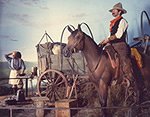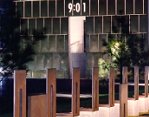| Oklahoma City | |
| http://www.sina.com.cn 2004/07/23 15:39 新浪教育 | |
语音讲解: AMERICAN MOSAIC - Jack Kerouac's 'On the Road' Manuscript Goes on the Road / Singer Eva Cassidy / Question About What to See and Do in Oklahoma City Broadcast: February 28, 2003 (THEME) HOST: Welcome to AMERICAN MOSAIC -- VOA’s radio magazine in Special English. (THEME) This is Doug Johnson. On our program today: We play some music by Eva Cassidy ... Answer a question about Oklahoma City ... And report about a famous book by Jack Kerouac. Kerouac Manuscript Tour HOST: “On The Road," the book by Jack Kerouac, was first published in nineteen-fifty-seven. Since then, it has sold more than three-million copies. It has been translated into twenty-five languages. It is often called a defining work of a group of writers during the nineteen-fifties known as “The Beat Generation.” Shep O’Neal has more.
ANNCR: “On The Road” is the story of two young men as they travel back and forth across the United States. The young men are Sal Paradise and Dean Moriarity. They and many of the other people who appear in the book are said to be similar to Jack Kerouac and his many unusual friends. Listen as the writer himself reads from “On the Road”: KEROUAC: "There he goes, Dean Moriarity, ragged in a moth eaten overcoat that he brought specially for the freezing temperatures of the East. Walking off alone, the last I saw of him, he rounded a corner of Seventh Avenue. Eyes on the street ahead, intent to it again. Gone!” Jack Kerouac worked intensively for three weeks when he was ready to put "On the Road" on paper. He typed it on several long pieces that he connected to form a continuous document. It rolls out to thirty-six-meters long. Two years ago, American businessman Jim Irsay bought the original “On the Road” for more than two-million dollars. He paid more than had ever been paid for a literary manuscript. Mister Irsay wanted the manuscript to travel across America in the years before two-thousand-seven -- the fiftieth anniversary of its publication. The document can be seen today at the Lilly Library at Indiana University in Bloomington, Indiana. It will remain there until May. Then it will begin its travels across the United States. Stops will include Lowell, Massachusetts; Orlando, Florida; Chapel Hill, North Carolina; and Milwaukee, Wisconsin. Tour organizer Myra Barshoff says “On the Road” may even travel outside the country. She is now trying to organize showings in Britain and Japan. Jack Kerouac wrote other books. But he had trouble with all the fame that "On the Road" brought him. He drank heavily. Jack Kerouac died in nineteen-sixty-nine. He was forty-seven years old. Oklahoma City HOST:
Our VOA listener question this week comes from Vietnam. Margie Cao Trang in Ho Chi Minh City has a question about Oklahoma City. She wants to know what a visitor to America can see and do there. Oklahoma City is the capital and largest city in the state of Oklahoma, in the south central United States. More than one-million people live in the area. It is one of the centers of oil production in America. Visitors to Oklahoma City can ride a water taxi boat through a new area of stores and eating places called Bricktown.
They can also visit the National Cowboy and Western Heritage Museum. There is also the International Gymnastics Hall of Fame. Visitors can explore through thousands of plants over at the Myriad Botanical Gardens. You can walk up a vine-covered mountain and under a waterfall. Outside the city is the Read Ranch. Visitors can ride on wagons to an Old West frontier town. They can watch horse races at nearby Remington Park. And they can enjoy live shows and fifty rides at the Frontier City Amusement Park. Yet, Oklahoma City is also known for something terrible that happened. On April nineteenth, nineteen-ninety-five, a bomb destroyed the Alfred P. Murrah Federal Building. A former American soldier named Timothy McVeigh was executed for the attack.
The city has built a memorial that includes parts of the destroyed building. Visitors enter the memorial area through a gate on the east side. This gate represents the time of nine-oh-one in the morning, just before the explosion. Visitors leave through the western gate which represents the time of nine-oh-three and the lives that were changed forever. Between the two gates is a reflecting pool and one-hundred-sixty-eight empty chairs -- one for each person killed. A tree that survived the bombing stands nearby. There is also the Oklahoma City National Memorial Center. This building contains a museum. It also contains a public policy research center that studies terrorism and political violence. Eva Cassidy HOST: Singer Eva Cassidy died more than six years ago. Not too many people knew about her then. But fame has now come to a life cut short by cancer. The story from Phoebe Zimmerman. ANNCR: Eva Cassidy became serious about music when she was nine. Her father taught her how to play the guitar. Eva would practice for hours. She could also sing many kinds of music: folk, pop, blues, jazz, gospel.
Years later, a friend brought her to a studio to record some music. Eva Cassidy went on to form a band and perform around Washington, D.C, where she was born. One of her favorite songs was “Oh, Had I a Golden Thread.” (MUSIC) During the summer of nineteen-ninety-six, Eva Cassidy learned she had melanoma, the most deadly form of skin cancer. Her friends organized a concert to honor her. Although very weak, Eva performed “What a Wonderful World.” She recorded this version earlier that year for her album “Live at Blues Alley.” (MUSIC) Eva Cassidy died in nineteen-ninety-six, at the age of thirty-three. Music critics said she was close to reaching a national audience at the time of her death. Now her music has gone not just national but international. "Songbird," an album released in nineteen-ninety-eight, became a top seller in Britain. Another album, "Imagine," came out last year. It includes this song by Eva Cassidy which we leave you with: “I Can Only Be Me.” (MUSIC) HOST: This is Doug Johnson. I hope you enjoyed our program today. And I hope you will join us again next week for AMERICAN MOSAIC -- VOA’s radio magazine in Special English. This AMERICAN MOSAIC program was written by Bob Brumfield, Lawan Davis and Nancy Steinbach. Our studio engineer was Tony Pollock. And our producer was Paul Thompson. 出处:《美国之音慢速英语经典》系列光盘产品 BiCulture工作室(www.biculture.com)
| |
| 【英语学习论坛】【评论】【大 中 小】【打印】【关闭】 |




